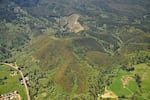The Oregon Department of Forestry has released a draft of a new management plan for hundreds of thousands of acres of state forestland on the west side of the state.
The Western Oregon State Forest Management Plan is the state's guide to achieving the "greatest permanent value" from its forests, as required by law. It aims to balance the economic, environmental and social benefits of 613,000 acres of state forestland that includes the Tillamook, Clatsop and Santiam state forests.
Finding the right balance of logging and environmental protection on these lands has been an ongoing struggle. Environmental groups have sued the state for allowing too much logging at the expense of threatened and endangered species while counties that share the logging revenue have also sued the state for not logging enough.
A jury recently awarded the counties more than $1 billion for the state's failure to generate enough logging revenue on its forestlands.
Meanwhile, the agency itself also depends on logging revenue and faces cutbacks when that revenue declines.
The agency has been working to revise the existing plan off and on since 2013.

Aerial surveys show the fungal disease Swiss needle cast is now infecting more than four times the forestland it did 20 years ago.
Courtesy of Oregon State University
The draft released this week includes plans to minimize the impacts of climate change on the forests and address lingering problems with Swiss needle cast and soil quality in the Tillamook State Forest. It changes the state’s goals, strategies and measurable outcomes for timber harvest, wildlife habitat and recreation, but critics say it’s unclear whether key targets for logging and for conservation have moved up or down.
Nearly all of the “measurable outcomes” listed in the plan call for the state to “minimize” some things such as agency spending on logging and the impacts of climate change; or they call for the state to “maximize” other things, like stream habitat conditions and the availability of trees for future cutting so they can be milled into lumber and other wood products.
Oregon Department of Forestry spokesperson Jason Cox said the revised plan is not expected to result in increased logging.
“It has some different strategies to try to achieve the balance of economic, social and environmental outcomes that we seek to provide in the state forests,” he said. “I wouldn’t say it is going to materially increase timber harvest levels.”
Related: Why Many Northwest Animals And Plants Need Wildfire
Bob Van Dyk with the Wild Salmon Center environmental group said the revised plan removes key targets from the current plan such as the goal of growing 30-50% of the forestland into “complex” stands with older trees that provide valuable habitat for threatened and endangered species.
“We’re extremely concerned about the plan,” Van Dyk said. “The plan has removed the hard conservation targets for older forests and stream strategies, and it’s replaced them with broad, vague statements about possible outcomes that the department will decide on its own.”
In a statement on the plan, ODF said the draft “encourages durable, longer-term conservation areas in state forests with a goal of 30 percent of the forest having a variety of plant species and ages present.”
Cox said the state expects to get a wide range of comments on the revised plan.
“Oregon is an ideologically diverse state and people have strong opinions and values about forest management and what a forest should provide,” he said. “It takes hearing from a lot of Oregonians with a lot of opinions to make sure we’re getting that balance as close to right as we can.”
The state's current and revised plan both follow a “take avoidance” strategy to avoid impacts to threatened and endangered species while logging parts of the forest.
Related: Oregon Lawyers In $1.4 Billion Timber Lawsuit Make Their Final Case To Jury
ODF will be taking public comments on the draft until Jan. 31, 2020. The Oregon Board of Forestry is scheduled to consider the revised plan next fall alongside an alternative idea for protecting endangered species while allowing for logging on state forests.
A Habitat Conservation Plan requires federal approval and allows for some impacts to threatened and endangered species while protecting the state from lawsuits.
Van Dyk said his group supports the idea of a Habitat Conservation Plan to guide forest management instead of a revised version of the Western Oregon State Forest Management Plan.
“I think if the state does pursue a Habitat Conservation Plan, this plan will largely get set aside,” Van Dyk said.
On Wednesday, the Oregon Department of Forestry will host a question-and-answer session on the revised plan from 9 a.m. to 3 p.m. at Broadway Commons, 1300 Broadway St. NE, Salem, Oregon, 97301.
